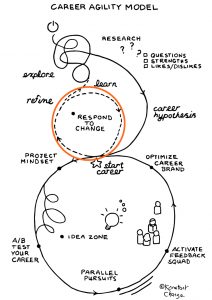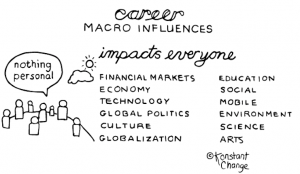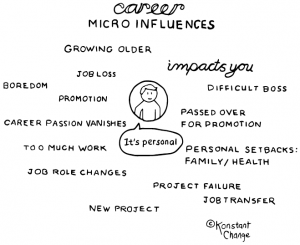
Respond to Change is a central principle to live by for the agile careerist. As a cornerstone of the Career Agility Model, this sensible principle is a fundamental aspect of growth as you step up to the modern demands of your career.
Adapt or perish, now as ever is nature’s inexorable imperative.
H. G. Wells 1866–1946
Carol Dweck, Professor of Psychology at Stanford, and author of Mindset states a growth mindset is critical to learning development and ability to improve. This incremental approach to moving forward is a complementary companion to the agile career mindset.
In the era of machine learning and artificial intelligence, our brain’s ability to adapt is a measure of our work survival.
But wait a minute. You want to do a whole lot more than survive, don’t you?
According to Ray Kurzweil, computer scientist, inventor, futurist, and author of The Singularity is Near, technology is accelerating at an exponential pace.
He suggests the future (highly influenced by technology) does not unfold in a liner progression, but advances exponentially. Which makes it harder and harder to predict what will happen in the future.
Due to the acceleration of technology, continuous change, and our inability to predict what comes next, careerists must be flexible and willing to adapt. Career agility, as defined by talent management executives Antoine Tirard and Claire Harbour-Lyell discuss in their book Disrupt Your Career the importance of change agility. According to the authors, embracing perspectives and viewing problems as opportunities will increase creativity, resourcefulness, and self confidence. Relating to my own research, this approach sets the stage for career change, a rational response to remaining relevant in the workplace.

While Fear, Uncertainty, and Change meet at the bar, the inevitability of change dominates the conversation. The bartender, listening and responding to their circumstances with empathy, offers the following advice,
Respond to change means:
- Leaning into change and making adjustments to your career status, rather than sticking to a rigid plan.
- Acclimating to economic developments and corporate adjustments by uncovering engaging projects.
- Discovering market and employment gaps you can fill in a unique manner.
When change is swirling around you, this is your go-to principle. By enacting this smart approach, you rev up the career agility engine when the world gets dicey and unpredictable.
That’s why I call it the superfood of the agile careerist principles.
Meanwhile, the threesome at the pub spins their story about how uncertainty and fear are the BFFs of change. They encourage you to accept the status quo by saying, “don’t ever change.” Bad advice from these mischievous brain interrupters.
Ignore the annoying distractions and deal with the change.
Sense and respond
When encountering the bar buddies, fear, uncertainty, and change, the Respond to Change principle encourages people to do two things:
- Notice the change
- Take action
As shifts happen, notice the change and take action, in spite of fear or uncertainty. These will occasionally derail necessary actions, but when you apply this street smart principle, you take control, rather than act as a passive bystander.
Fear of descending down Alice’s infamous Wonderland rabbit hole keeps some of us in place, until something happens to us.
Sound familiar?
Unexpected change happens, and we react, rather than take strategic action. The situation evolves into an urgent crisis demanding attention, instead of a deliberate choice.
Action figure
You might think you are powerless to take action, yet a friend of mine took action three times, while raising children and dealing with a complicated household. Personal change—like parental responsibilities—often precede the opportunity to modify your career path.
My friend moved from a medical device sales position, which required a lot of travel into acute care nursing. Her goal was to lessen the travel and be more available for grade school schedules, and other child rearing challenges.
Seeing the opportunity to advance, she moved into nursing management. A few years later, it became clear technology was going to alter everything for her profession. She moved to a system design and software integration role. The position required communication with healthcare workers, and a system designed to enable electronic access to medical records.
Her unique qualifications put her at the top of the candidate list, as the role required a medical background and a willingness to learn technology. The new position resulted in more money, more flexibility, and remote working options.
By responding to change, she enhanced her work life communicating the essential empathy for users of the system.
Path: Sales > Nursing > Nursing management > Healthcare IT design and integration
Dimensions of change
Situational awareness is the first step in implementing this important principle. Look for any of the following types of influences and trends impacting business professionals today. Macro developments affect everyone, whereas micro changes are specific to you as an individual.
Macro influence
Macro change, like the Global Financial Crisis of 2008, or the rise of mobility trends that tether us to our “always on” devices affect everyone. The same is true for advancements in science or the globalization of our economy. Each of these elements is part of a complex interdependent system, in a constant state of evolution.
My book Activate Your Agile Career contains many stories of individuals who recognized the macro changes in their career environments, and shares some of the agile actions they took to address these changes with confidence.
My friend’s story illustrates the important decisions affected by both macro and micro change.

Micro influence
Micro change feels personal. You may be in a difficult place, where your boss is increasingly unreasonable or crazy. Maybe you were passed over for a promotion. Or your job function was eliminated and you are in scramble mode, rather than a mode of deliberate intention.
Home circumstances like healthcare setbacks, a divorce, or an impending geographic move are examples of situations that affect our work lives.
 There are other developments close to you that are less personal, yet no less disruptive. A change in corporate structure, or a new department project can have ripple effects from the highest levels in the organization all the way to you.
There are other developments close to you that are less personal, yet no less disruptive. A change in corporate structure, or a new department project can have ripple effects from the highest levels in the organization all the way to you.
Direct-impact change can feel like an earthquake, affecting the stability of your life and the ground where you plant your feet.
Dreams, dashed in an instant, may feel like a dream stealing headache, where a steady drip of negative influences erodes at the core. You may witness a slow-motion movie flop in an infinite loop, playing over and over and over again.
Our friends at the bar, Fear, Uncertainty, and Change, may become dangerously close to messing with your head.
The next time you meet these instigators in the bar, it’s time to respond with arms akimbo in a power stance. Give them a look that says, “I mean business,” and fight back with the Respond to Change principle.
When you’re in control, this principle becomes the advocate for your life’s work, as you calculate what’s next. Integrate a Respond to Change mindset into your personal career navigation algorithm.
Change is an unavoidable and recurring element in our work environment. Anticipate, rather than avoid the inevitable disturbances to your balanced and steady state.
Equip yourself with what you need to respond to change by joining a community of agile careerists like you. Read how professionals responded to the macro, and micro, changes of their careers in the book, Activate your Agile Career.
How have you managed fear, uncertainty, and change?
